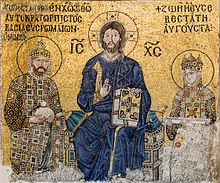Constantine IX

Constantine IX Monomachus ( Middle Greek Κωνσταντῖνος Θʹ ὁ Μονομάχος ; * around 1000 ; † January 11, 1055 ) ruled as Emperor of Byzantium from June 11, 1042 until his death.
Life
In his second marriage Constantine was with a niece of the Emperor Romanos III. married who died around 1035/1036.
He had been appointed husband and co-emperor by Empress Zoë in 1042, although he had been banished because of a conspiracy against her former husband Michael IV . They ruled together until Zoë's death in 1050.
Immediately after taking office, Constantine put down the rebellion of Theophilos Erotikos in Cyprus , who had exploited the chaos of the throne in Constantinople to set up his own business. In 1043 he released General Georg Maniakes from his command in Italy , whereupon Maniakes proclaimed himself emperor. His troops had in mind the victory over Constantine's general Stephanos Pergamenos in the decisive battle, when Maniakes was wounded and died on the battlefield. Immediately after the victory, Constantine was attacked by a fleet of the Kievan Rus , which had probably been asked for help by Maniakes. She too was beaten - with the help of the Greek fire . In 1047 Constantine IX kept it. narrowly got the upper hand over the usurper Leon Tornikes , who had risen to become emperor in Macedonia and almost conquered Constantinople.
After the battles against the Bulgarians, the emperors Johannes Tzimiskes and Basil II had shifted the Byzantine dominion in Europe between the Danube and the Adriatic to the approximate limits of the division of the empire of 395 AD to the west. The incursions of the nomadic Pechenegs , Uses and Cumans into the themes of Paristrion , Macedonia and Thrace (1027, 1032 and 1034 to 1036) threatened these properties and caused great damage. The worst year was 1048 when hundreds of thousands of Pechenegs came to the country, destroyed the Byzantine-Slavic settlements and settled in the Balkans . The imperial troops were defeated at Marcianopolis (Devnja), Hadrianopolis ( Edirne ) and Preslaw , the former capital of the Bulgarian Empire . Constantine IX was finally able to negotiate a thirty-year peace treaty. The aim was to settle the Petschenegen in the area of Paristrion.
In 1046 the Byzantines first had contact with the Seljuks . They met in a battle in Armenia in 1048, but signed an armistice the following year. In 1053 Constantine was forced to dismiss his Armenian troops for financial reasons, so that he could only leave the eastern border of the empire under poor protection.
In 1054, the centuries-old dispute between the Orthodox Church and Roman Catholicism led to the final separation of the two faiths. Legates of Pope Leo IX. excommunicated the Patriarch of Constantinople Michael I Kerularius when he refused to accept Western ceremonies; in return, Kerularius excommunicated the legates. Constantine's attempts to forge an alliance with the Pope against the Normans were thus useless.
Constantine tried to intervene, but fell ill and died on January 11 of the following year. Theodora III. , Daughter of Constantine VIII , who had already ruled once with her older sister Zoë, had the designated heir to the throne Nikephoros Proteuon put in a monastery and ascended the Byzantine throne for the second time. The chairman of the Senate Theodosios Monomachos , as the nephew (or cousin) of the dead emperor and a promising successor candidate, was also left empty-handed.
Constantine was the patron of the scholar Michael Psellos , whose Chronographica records the history of Constantine's reign. The monastery of St. George of Mangana was built under the rule of Constantine, and the emperor played a major role in its construction. Psellos reports on his landscape gardening undertakings with quiet mockery.
literature
- Alexios G. Savvides, Benjamin Hendrickx (Eds.): Encyclopaedic Prosopographical Lexicon of Byzantine History and Civilization . Vol. 2: Baanes-Eznik of Kolb . Brepols Publishers, Turnhout 2008, ISBN 978-2-503-52377-4 , pp. 252-254.
- Peter Schreiner: Konstantin. IX. Monomachus . In: Lexicon of the Middle Ages (LexMA). Volume 5, Artemis & Winkler, Munich / Zurich 1991, ISBN 3-7608-8905-0 , Sp. 1378.
- Peter Wirth: Constantine IX. Monomachus . In: Biographical Lexicon on the History of Southeast Europe . Vol. 2. Munich 1976, p. 460 f.
Web links
Individual evidence
- ↑ Lyudmila Dončeva-Petkova: To ethnicity of some necropolis of the 11th century in Bulgaria . In: Post-Roman Towns, Trade and Settlement in Europe and Byzanticum. Volume 2. Verlag Walter de Gruyter, Berlin 2007. ISBN 978-3-11-018358-0 , pp. 643–644 (in German)
| predecessor | Office | Successor |
|---|---|---|
| Zoë and Theodora III. |
Emperor of Byzantium 1042–1055 |
Theodora III. |
| personal data | |
|---|---|
| SURNAME | Constantine IX |
| ALTERNATIVE NAMES | Konstantinos Monomachus |
| BRIEF DESCRIPTION | Emperor of Byzantium |
| DATE OF BIRTH | around 1000 |
| DATE OF DEATH | January 11, 1055 |